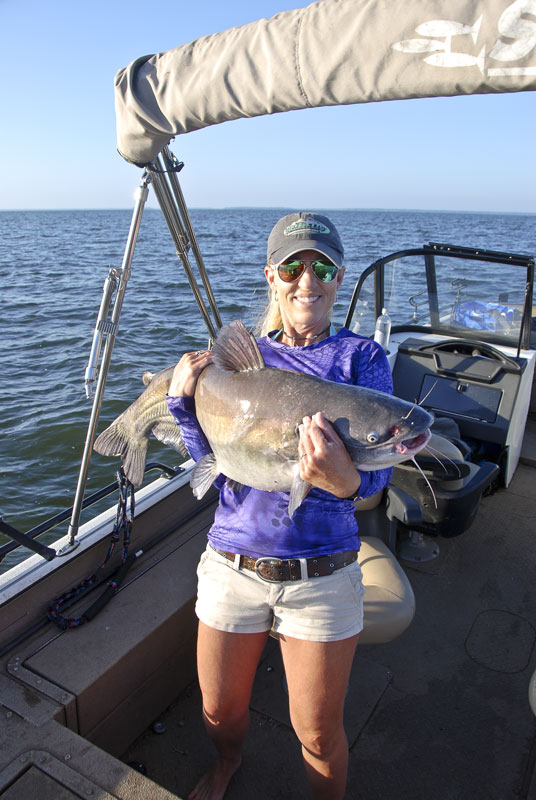
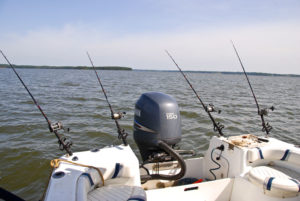
What features do you need on your ultimate catfish boat? How you outfit and rig the hull can make fishing a breeze or a battle.
Anglers have been lining the banks of the Mississippi River for eons to catch catfish.
As targeting them evolved into a solid pastime, anglers began leaving the shoreline, using dinghies, barges and other more commercial vessels to chase their prey.
Not long ago, someone regarded as exclusively a catfish angler still used the most basic, unsophisticated craft to anchor up and drop lines with pieces of cut bait over the side.
But today, heads are more likely to turn to look at one of today’s modern catfishing machines as another run-of-the mill bass boat.
Boats intended to target catfish now come with every amenity, from heated seats to temperature-controlled , oxygenated livewells and every bell and whistle in between. Choosing your catfishing boat is no longer a mundane job.
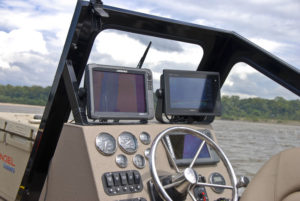
According to Roy Harkness, a veteran tournament catfish angler from Ripley, Tenn., acquiring a boat is the easy part. The hard part, he said, is figuring out how to rig it exactly the way you want it.
While some anglers may argue the first part of this statement, few can argue with the second part. Rigging a new boat requires time and patience in order to get all of the catfishing components — rod holders, bait tanks, livewells, seating, trolling motor and sonar units — situated on the first try without have to re-drill holes and re-clamp bases on a new boat.
“I don’t start drilling holes and permanently attaching things until I’ve made several dry runs with the boat,” Harkness said. “I can run and pick up a new boat the same day, but it takes me weeks — and maybe as many as a dozen trips — before I get everything installed where I want it.”
Whether you’re outfitting a brand-new boat or just a new-to-you boat, rigging it to provide optimal performance for a tournament or just a day of fun fishing is no easy task.
Harkness has some pointers from his years of experience rigging catfish boats.
Rod holders
A firm believer in and user of Driftmaster rod holders, Harkness said his preference is to clamp some of the rod bases on the rails that go around the rear gunwales of his Sea Ark Dynasty catfish boat, as well as to screw some of the rod-holder bases directly to the deck of the boat.
“The first few trips are without any rod holders; I just lay the rods where I want them to go,” he said. “You can do mock-ups sitting on the trailer in the driveway, but until you get out there and fish and see what potentially works, you’ll never really know.”
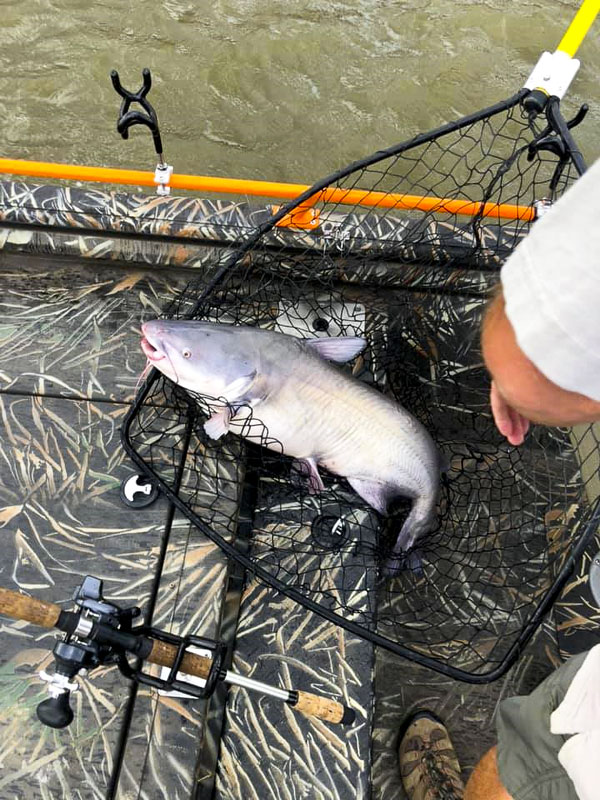
Sonar Placement
The No. 1 priority to where Harkness mounts his 12-inch Garmin sonar units is allowing himself line of sight, a safety consideration, especially when running in the dark.
“I use several different RAM mounts to place my units out of my way but still easy to see,” he said. “A good example is my chart plotter. I want it out of my direct line of sight but in my peripheral area so I can glance at it and keep track of where the boat is.”
Like the rod holders, he’s not afraid to connect his sonar units and lay them on the dash in an effort to see what works best before attaching the mounts to the boat.
Livewell
Harkness said his boat has a 100-gallon livewell built into the rear deck, but other boats may not have one or one that size. He suggests keeping the livewell in the back, closer to the motor, so the boat will get on plane more easily.
“Check out the pumps and the wiring and make sure to check it all out before you’re relying on that livewell to keep your fish alive,” he said.
As for bait wells, he rarely has a need for live bait, but he does store his bait cooler on the front deck, strapped down and out of the way.
“I keep the bait up front on the other side of the windshield,” he said. “That keeps the bugs and the smell out of the back where we’re fishing.”
Trolling Motor
Harkness’ final advice on rigging is to make sure the trolling motor will clear other gear when deployed and stowed. He said he’s also learned the hard way to mount the motor so the head is inside the edge of the boat. This prevents the head of the motor from getting damaged if he’s trying to dock in or against strong currents.
“I use my trolling motor in a lot of heavy current situations, whether I’m bumping or drifting or just trying to put the boat in position,” said Harkness. “You want a reliable model with enough power to move a pretty heavy boat in strong current, but you also need to have it set so you can deploy it and stow it pretty easily when it’s time to move.”
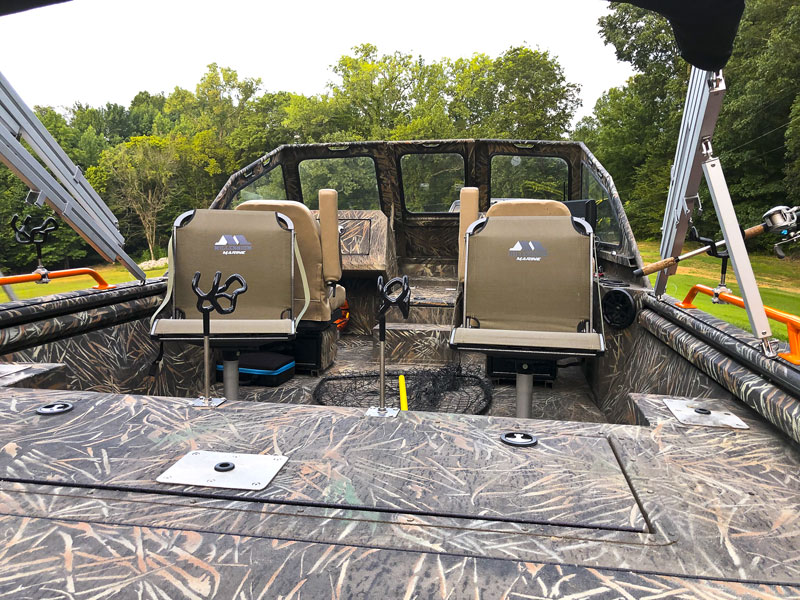
The perfect catboat?
A highly debated topic in catfishing circles is what makes the best catfish boat? But instead of arguing over who, look at the specs and features that are best suited for the task.
Starting at the front, the first decision is Deep-V or open front deck. Both have advantages and disadvantages. The argument is often that most catfishing is done from the rear of the boat, so a stout V-hull becomes a necessity when plying big waters like the Mississippi River on a high-water day. Open front decks allow more walk-around room and more gear-storage capacity.
The next consideration is layout and floor design. Arguments can be made for center consoles, wrap-around windshields or open design. While center-console models frequently come with T-tops that provide shelter from the sun, heat, wind and rain, others voice support for wrap-around windshields that allow for clear views when underway and support retractable Bimini tops to protect anglers from the elements.
Seating arrangement is another concern with floor plan. Will anglers primarily be fishing standing up or sitting down? What tactics do you plan to use the most? It’s tough to stand for hours on end, waiting on a rod fished at anchor to go down.
Bumping anglers don’t have much time for sitting and frequently range all over the boat, but primarily on the rear deck.
Because modern catfishing boats tend to run on the rather large, heavy and metal side, you’ll want enough motor to push the boat. Four-stroke outboards dominate the catfish market these days. The question is, how big of a 4-stroke outboard do you need? Can you get by with 115 or 150 horsepower or do you have a boat that won’t get on plane without a bigger outboard?
Storage is another concern. Most catfishermen don’t need much room to store baits, but a considerable amount of space is needed to accommodate rod lockers and huge livewells.

